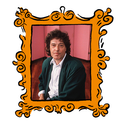the first great ape to reach Britain and survive for any length of time was a chimpanzee called Tommy, who was exhibited in London Zoo in 1835 before he died of tuberculosis. He was replaced in 1837 by an orang-utan called Jenny. She died in 1839 but was replaced by another, also called Jenny.
These apes caused a small sensation. Queen Victoria, who saw the second Jenny, typified the reaction of horrified fascination. Jenny, she wrote, was "frightful, and painfully and disagreeably human." It was disconcerting that an animal could look and behave so like a human. It posed uncomfortable questions about the distinction between people and animals, reason and instinct.
Charles Darwin visited the first Jenny in early 1838, less than two years after returning from the voyage of the Beagle. A few weeks later, he wrote in his notebook, "Let man visit the ouran-outang in domestication... see its intelligence... Man in his arrogance thinks himself a great work... More humble and I believe true to consider him created from animals." This was 20 years before he unveiled the theory of natural selection. It was several months before he had his main insight into the struggle for existence after reading Malthus's essay on population.
To most people, Darwin is synonymous with animals and plants. To explain natural selection, he called on pigeons, Galapagos finches and orchids. While procrastinating over the publication of natural selection, he spent eight years studying barnacles. His last book is called, sensationally, The Formation of Vegetable Mould Through the Action of Worms. This was the epitome of an unworldly, reclusive naturalist.
The fact that he also dethroned man from his place atop the natural world by establishing the fact of evolution seems almost incidental to his natural history. In The Origin of Species, he famously confined himself to a single gnomic sentence about his own species: "Much light will be shed on the origin of man and his history." He left it to Thomas Huxley to argue with bishops about being descended from monkeys.
Or so goes the conventional wisdom. But far from being just a naturalist, Darwin was an obsessive observer of human beings. Instead of coming to overturn human exceptionalism via the study of animals, Darwin did almost the opposite. He started with human nature, concluded that it was different from animal nature only in degree, not in kind, and from there worked back to natural selection. His breakthrough owed as much to Hume and Wordsworth as to the finches and tortoises of the Galapagos islands.
This revolutionary claim is contained in a book published in May by Randal Keynes, Darwin's great-great grandson, called Annie's Box. A fine contribution to Darwiniana, it centres on his private life and the central tragedy of his experience-the death, at age ten, of his beloved daughter Annie, from consumption.
Though much praised, the book has suffered from an unusual degree of reviewer myopia. Most critics expected a revelation about the effect of Annie's death upon Darwin's thinking, perhaps reinforcing the bleak lesson taught by survival of the fittest. Though it is true that her death probably put the final nail in the coffin of Darwin's Christian faith (after it, he would walk his family to church, but not enter), for Keynes the story of Annie is different. He has tried to show how Darwin's experience of fatherhood fed into his thinking from the start. Keynes says that Darwin "learnt from his feelings for Annie about the lasting strength of the affections... and the limits of human understanding."
In his relationship with Annie and his other children, Darwin emerges as anything but a typical Victorian. He was a warm and approachable father, who allowed the children to play roughly in his study. His approach to child-rearing was liberal and tolerant. Both his grandfathers had been admirers of Rousseau's dicta, that parents should be permissive and encouraging (not that Rousseau took his own advice: he insisted on his mistress sending all his children to an orphanage). Darwin's children were well treated. In his "memorial" to Annie, he writes: "her tender love was never weary of displaying itself by fondling and all other little acts of affection."
Keynes has recently put the real Annie's box on show in a special exhibition at Darwin's house in Kent. The box is a writing case with various family mementoes of Annie put away by her mother after her death and rediscovered by Keynes recently. This is part of a general refurbishment of Down House by English Heritage, which now includes a fascinating recreation of the garden in which Darwin did so many experiments with pigeons, bees or plants. He grew no less than 54 varieties of gooseberry, for example. Plans are now afoot for a Charles Darwin centre for conferences on evolutionary theory.
There is probably no scientist for whom the sense of place is as strong as it was with Darwin. Having circumnavigated the world, he came to anchor in this little corner of Kent, so close to suburbia even then, but secluded in the hedges and banks of the North Downs. His every idea was tested and observed in some corner of this patch of land, fermented in his brain during "thinking walks" and written up in the cluttered study now restored to its original appearance. More relevant features remain of Darwin's milieu than of Newton's, Mendel's, Einstein's or Watson and Crick's. Down House is a scientific shrine of the finest authenticity.
And it is impossible to separate Darwin's science from his home life. Keynes shows they were all of a piece. He never "went to work." He enlisted the entire household into his inquiries. The children were made to track bees, their governess to count plants and the butler to boil the skeletons of pigeons. The children were not just lab assistants. They were also subjects. From their earliest moments they were under close observation. In his book, The Expression of the Emotions in Man and Animals, he detailed the emergence of reflexes and habits in young children-his own. In The Variation of Animals and Plants under Domestication, he refers to a certain habit of twiddling the fingers when pleased that he had observed in a boy, and how the boy's daughter had developed the same habit. The boy was himself; the girl his daughter, Betty.
He also recalls repeating on the one-year old Annie an experiment he had first done with the orang-utan Jenny: to see if each could recognise herself in the mirror. The evolution of the human mind must at least be possible, he argued, "for we daily see the faculties developing in every infant."
The question of human nature and whether it is an exception to brute nature was a central concern for Darwin from 1838. A few months after seeing orang-utan Jenny, Darwin found what he felt was an answer to the main obstacle to seeing human nature as derived from animal nature: human morality. His notebooks show that he had developed the idea that the notion of right and wrong might be rooted in a "social instinct" that had once contributed to survival. Conscience, he thought, might be "an hereditary compound passion"-though he also emphasised the role played by self-awareness and reflection. The reason we find it hard to analyse our moral motives might be because they were "originally mostly instinctive." These were very similar to thoughts expressed by Wordsworth in his Lyrical Ballads. They were also a far more radical heresy in the pious Victorian age than evolution itself.
Keynes's disinterment of this strand of Darwin's thinking is remarkable for three reasons. First, it shows how much putting man in his place in nature was at the beginning, not the end, of Darwin's evolutionary reasoning. Second, it reveals Darwin as a full-blown "evolutionary psychologist," ready to speculate about the evolutionary origins of complex human behaviour. Such speculation has flowered in the past decade much to the rage of conventional social scientists, who call it biological determinism. Third, it shows how little progress we have made. More than 160 years have passed since Darwin thought these thoughts about human exceptionalism, yet to write what he wrote would still get you condemned in most public prints.
Take this quotation from a pamphlet by Kenan Malik, "What is it to be human?" just published by the Institute of Ideas: "Humans are not like other animals... we must distinguish between inert, mechanical nature and active, thinking man." More than a century after Darwin demonstrated that there is no hard distinction between nature and man, only differences of degree, Malik's appeal to human exceptionalism is still supported by most of the academy. It has been the presiding assumption of the followers of Durkheim, Freud, Boas, Piaget, Skinner and Foucault for 100 years: that there is a greater gulf between a person and a chimpanzee than there is between a chimpanzee and a slug.
Social scientists allowed Darwin his triumph over anatomy, but barred him from the mind. That was to remain determined exclusively by culture (that is, by other people's minds). Some scientists have even argued that Darwin himself did not intend his ideas to extend to psychology. But even a cursory reading of Darwin's later books, or his early notebooks, reveals otherwise.
Yet Darwin's foundations were hardly built upon in the 20th century. I wrote a book (The Origins of Virtue) on this theme, trying to demonstrate that the "good," pro-social human habits might just as plausibly have long evolutionary antecedents as the "bad," anti-social ones. I am embarrassed to find how much I failed to acknowledge Darwin's contributions to the argument. We say of a drunken yob, "he is behaving like an animal." We never say of somebody who initiates or reciprocates a kindness, that she is "behaving like an animal." Why not? There is just as much evidence for instinct in our good behaviour as in our bad. In any case, I was condemned by many social scientists for various heresies against environmental determinism.
There is a trap here for the unwary. To argue that human beings are no different from other animals is just as foolish as to argue that they are completely different. Humans are unique. They have language, written culture and opposable thumbs. But elephants are unique, too. They have trunks. So are goldfish. As Helena Cronin once wrote, "there is nothing unique about being unique." The trick in comparative biology is to find the similarities between species that speak of common descent or convergence, and to find the differences that speak of adaptation to particular ecological conditions or genetic accident.
This is no less true in behaviour than in anatomy. The male gorilla has a huge body, but tiny testicles; the male chimpanzee has by contrast a modest body and enormous testicles. The difference reflects the fact that competition between male gorillas happens before fertilisation (in fights over harems), while competition between male chimps takes place after fertilisation (as the sperm from several mates compete to reach the egg). This in turn has behavioural consequences: infanticide is common in gorillas when harems change hands because males are certain about paternity. It is rare in chimps because the issue of paternity is blurred. Why must we assume that the testicle size of the third African ape (ourselves) tells us nothing about its behaviour? We are, in fact, intermediate between chimp and gorilla, which is inconsistent with chimp promiscuity or gorilla polygyny, but consistent with a mostly monogamous mating system.
Darwin would have loved this data. It demonstrates the power of his neglected second great theory, sexual selection. And it makes clear the futility of drawing a hard line between man and animals. It is astonishing to realise that between Tommy's arrival at London Zoo in 1835 and Jane Goodall's studies in Tanzania beginning in 1960, we knew nothing of the complexity of chimpanzee social lives, in part because we assumed that we had a monopoly on complex, conscious behaviour. You still hear philosophers and neuroscientists talk of consciousness as if it were a purely human phenomenon, though anyone who has watched a dog dreaming knows otherwise.
Darwin drew no dividing lines through nature. Although he knew three natives of Tierra del Fuego who returned home on the Beagle after a spell in London (including a visit to court) and was "struck by how similar their minds were to ours," he was none the less shocked by his first sight of "wild" Fuegians. "They were naked and sent forth most hideous yells... man in his most savage state... the reflection at once rushed into my mind-such were our ancestors." If the three Fuegians on board had stepped so easily into civilisation, perhaps he was only a step away from sinking into savagery. Having seen the animal in himself, he was ready, as few Victorians were, to see orang-utan Jenny, as a cousin.
Towards the end of his life, Darwin was drawn back to human exceptionalism. But he began to worry that (in Keynes's words) "the human brain was not a perfect instrument for finding truths." This is a doubt that goes back to Hume, and Colin McGinn has recently coined the term "mysterian" for the belief that while there is nothing supernatural about consciousness, it may still be beyond the comprehension of the human mind.
Darwin's last book, The Formation of Vegetable Mould Through the Action of Worms contains the final irony. His point was to show how dramatically worms changed the appearance of the world by their churning of the earth, but he could not resist speculations on their "mental qualities." He brought worms into the house to test their reactions to the piano. This was a man who treated worms as sentient beings and children as experimental subjects. For 40 years he pursued the idea that humans were just another kind of organism wherever it would take him. Few since have had the courage to follow him.











